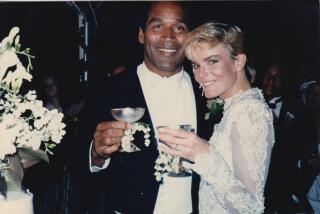A Battered Wife Wins Acquittal in Murder Case
- Share via
During their 6 1/2-year marriage, Jack Elson shopped for his wife’s clothes, decided which outfit she would wear each morning and determined the course of her day with a list of chores. He restricted her nail polish to pale pink and peach, forbade makeup, decided what she would cook for dinner, told her what groceries to buy and matched the change she received against the receipt.
In the beginning, the beatings were sporadic. He would slug her with closed fists because the pork chops were dry, punch her in the stomach while she was pregnant because the toast was burned, then apologize with flowers.
“If he told me I was stupid, I believed it. If he told me he would kill me, I believed it. If he opened the door and said, ‘Go,’ I wouldn’t, for fear he’d stab me in the back on the way out,” Robin Elson said. “I was a robot.”
But the decision was hers the evening of Dec. 17, 1988, when she crept behind her husband’s brown reclining chair, stood her 4-foot, 9-inch, 70-pound frame against the wall and shot him to death with his 9-millimeter rifle.
Last month, a Long Beach jury decided the 28-year-old mother of three killed her husband in self-defense. The case was little noticed until it ended. Since then, it has sparked heated debate.
Domestic violence experts believe the verdict to be the first time in Los Angeles County, and possibly the state, that a woman has been acquitted of murder using a defense based on the “battered wife syndrome.”
The law requires there be “imminent danger” to justify killing in self-defense. What made Robin Elson’s case unusual is that she shot her husband three times in the back while he sat in his chair, possibly asleep or passed out from too much vodka.
The controversial verdict has been hailed by women’s rights advocates as long-overdue recognition of the battered woman’s mental state.
Her defenders say Robin Elson was trapped--taught through years of punching and berating, from window screens nailed shut and doors barricaded with heavy furniture, from the two times she tried to escape and the two times her husband found her--that she could no more leave her house than fly to the moon.
“It’s like the scientific experiment where they shocked dogs to the point that even when the gate was left open, the dogs never left,” defense attorney Lynda Vitale said. “The dogs saw the open gate not as a means of escape, but an invitation to more punishment.”
But prosecutors have denounced the verdict as a throwback to jungle law.
“Is this a signal that men who get frustrated by the actions of their wives can kill them? That whenever we get frustrated with someone we are entitled to exact the ultimate sentence--death?” said Denis Petty, head deputy district attorney in Long Beach.
“She could have left the state, gone to a neighbor, called the police. He was asleep when the first shot was fired. He wasn’t posing any threat. And when we start allowing citizens to take matters into their own hands, we are back to the law of the jungle.”
Although prosecutors disagree with the verdict, they do not dispute that Jack Elson was abusive most of his life. The following account is based on court testimony, neighbors’ recollections and interviews with Robin Elson.
According to the psychologist who testified at her trial, Robin Elson’s story began not when she fired the rifle, but on July 4, 1950, when Jack Elson moved at age 5 with his little sister and two alcoholic parents to the same corner house on Pavo Street where he would one day live with Robin.
The Elson family never fit in on the middle-class block of manicured homes where Jack grew up and where some of the same residents still live today. When Jack and his sister were thrown against a wall for some childhood infraction or left alone at night while their parents went drinking, the neighbors kept their distance.
When Jack got big enough, he once gave his mother a beating for burning a chicken. When he inherited the house years later and lived there with Robin, their two sons, and Robin’s daughter by a previous relationship, the neighbors said the sounds of violence were already routine.
They knew why Robin wore sunglasses to the garage to do the laundry. They heard children in the house pleading, “Please, Daddy, don’t.”
As Jack’s violence escalated, the neighbors’ aversion turned to fear. But no one ever called the police.
“I knew what he was like. I tried not to irritate him. I was scared to death of that man,” said Nola De Martino, 74.
She was cleaning her motor home one day when she saw Jack order stepdaughter Renee, then 6, to do 100 push-ups on hot cement.
“She kept collapsing,” De Martino said. “He made her start over from 1 and do 100. She was saying, ‘Please, I can’t do this, please.’ I got so scared I went back in my house and turned on the security system. I was afraid he had seen me.”
Ann Bennett, who lived three doors away, remembers a day in 1987 when Jack jammed a garden hose in the mouth of his 18-month-old son, Camrin, and turned on the water. She walked into her house and shut the door.
“Oh God, “ Bennett said. “Camrin was crying. ‘Shut up, shut up,’ Jack kept saying and he would poke the hose down his throat. I was afraid to say anything for fear he would do me harm. That kid was screaming at the top of his voice. That hose was going full force. I am surprised the kid didn’t die.”
But there was no evidence of Jack Elson’s rage the June, 1982, day when he met Robin. At 5 feet, 8 inches and a solid 188 pounds, he was a handsome auto mechanic who could fix anything.
She had an 11th-grade education, a job selling Avon products and no driver’s license. He opened her car door, lit her cigarettes, pulled out her chair and cooked romantic dinners. “I figured my knight in shining armor had finally come,” she said.
When they married two months later, he showed up 45 minutes late and drunk. He never mentioned he had married four times before, that one of his wives was hiding from him and another had sought a restraining order when he beat her for slicing onions too big.
Robin said her first beating came six months after the wedding, when she objected to Jack spending a Saturday fishing with a buddy. He asked his friend to wait outside and blackened both of her eyes.
He cut her off from her friends. He drank almost constantly. The beatings intensified while she was pregnant with their second son, and she left him. He found her at her mother’s house two weeks later and promised to kill them all if she left again.
Baby Brock arrived two months premature. When Robin Elson came home from the hospital, 9-year-old Renee was on the couch with ice packs, her eyes swollen almost shut, her upper lip touching her nose.
One day in the spring of 1988, Jack spent 2 1/2 hours beating Camrin, then 2. He held him upside down by the ankles and pounded his head against a black metal table over and over again. The boy was bleeding from the ear when his father put him to bed and announced, “He’ll never look at me like that again.”
Two months later, when Jack passed out in his chair, Robin packed two shopping bags with clothes and took $20 she had taped under a table. Hiding with the children in the back room of an auto parts store, she spent four hours on the phone hunting for a battered women’s shelter.
They were placed in a secluded trailer in East Los Angeles. Six months later, she opened the door for what she thought was a friend delivering a television set and found Jack Elson standing there instead.
He promised to reform. But when they returned to Pavo Street, he took away her check-cashing card and house key. He quit his job and never left the house without one of the children. Sometimes he took the telephone, too.
“He told me 50 times a day he would kill me and the kids if we ever left again,” Robin said.
Domestic violence experts estimate that less than 1% of battered women kill their husbands. Those who do “don’t get off easily,” said Nancy Kaser-Boyd, a Studio City psychologist who testified at Elson’s trial.
Kaser-Boyd’s recent study of 20 Los Angeles County women who killed their mates showed three-quarters had been battered. All but one was convicted of second-degree murder or voluntary manslaughter. The only exception was a mistrial.
Under the law, it is permissible to kill in self-defense when confronted by circumstances the “average reasonable person” would consider an “imminent danger.” That generally excuses women who kill their mates while being attacked, Kaser-Boyd said.
But it is not unusual for a severely battered woman to believe her life is in constant danger and retaliate when her husband is least likely to strike back, the experts say.
Juries, however, typically have rejected the argument that a woman is in imminent danger if her abusive mate is at rest, partly because expert testimony about the battered wife syndrome has been excluded by some judges as irrelevant and restricted by others, the experts say.
Long Beach Superior Court Judge G. William Dunn, who presided over Robin Elson’s case, said if 50 juries had been presented the same set of facts, 48 of them might have convicted her.
But Dunn allowed some of the most ample testimony about the battered wife syndrome ever admitted in a Los Angeles County court. That helps explain the jury’s finding of innocence, defense attorney Vitale contends.
The verdict has boosted the resolve of several prominent women lawyers who are drafting legislation to uniformly allow such testimony in California courts, said Sheila Kuehl of the Southern California Women’s Law Center.
Saturday, Dec. 17, 1988, was set aside for buying a Christmas tree. But Jack Elson started drinking straight vodka at 7 a.m., according to testimony, and spent several hours kicking and choking his family instead.
He poked the garden hose down the throat of the family’s pet terrier, Maggie, then threw the dog on the roof. He decided two men were going to break into his house and rape the children. He ordered his wife to retrieve his rifle, inserted the clip and taught her how to use it.
While the children hid in a bedroom, he poked Robin’s chest with the rifle barrel. “It’s time to get rid of you, you illiterate slut.” he said.
Then he set the rifle by his reclining chair, placed the phone at his side and sat down to watch “The Little Rascals.”
The children had not eaten for hours. Robin went to the kitchen to make spaghetti, but Jack kept calling her back to the living room. She said she was convinced they were all going to die that night.
Then it was quiet. Gambling that he was asleep, she crept on her hands and knees into the living room and slid the gun from beside the chair. She stood and leaned against the wall. The gun fired.
The bullet passed in and out of the top of Jack’s head. The chair’s foot rest dropped. He sprang forward and blurted an expletive. She fired twice more into his back. The fatal bullet pierced his aorta.
For the first time, a neighbor called the police.
Robin Elson and her children live now in a two-bedroom apartment in Long Beach. She has put on 25 pounds and is trying to quit smoking. The family is in extensive therapy. Renee’s grades are improving.
The house on Pavo Street is empty, seized by the state. A neighbor cut the lawn when it grew too high.
“He got what he deserved,” one of them said.
Nola De Martino looks at the house, finally quiet, from her kitchen window. “I cry about it and I pray about it. I even prayed for Jack that he wouldn’t go to hell,” she said. “But I don’t know how he couldn’t.”
More to Read
Sign up for Essential California
The most important California stories and recommendations in your inbox every morning.
You may occasionally receive promotional content from the Los Angeles Times.










